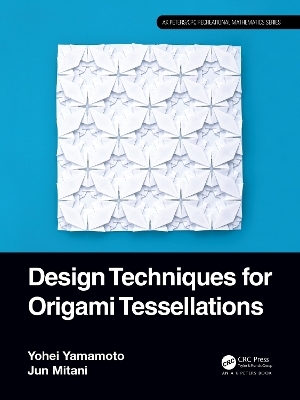
Design Techniques for Origami Tessellations
Taylor & Francis Ltd (Verlag)
978-1-032-45384-2 (ISBN)
This book begins by explaining general design methods, the history and definitions of origami tessellations, and the geometric features of flat origami, before moving on to introduce a brand-new design method: the "twist-based design method." This method generates base parts that connect "twist patterns” (that can be folded with a twist) without using a lattice. Therefore, it can generate base parts such as regular pentagons, which cannot be generated with more conventional methods, and can generate new origami tessellations connected to them.
Features:
No proofs or formulas in the text and minimal jargon.
Suitable for readers with a roughly middle school to high school level of mathematical background.
Web application implementing the method described in this book is available, allowing the readers to design their own patterns.
Yohei Yamamoto is a researcher of Information and Systems at University of Tsukuba. He received his Ph.D. in engineering from the University of Tsukuba in 2023. He has been in the present post since April of the same year. His research interests center on origami design and geometric modeling techniques. The origami artworks created by him have features that are geometric flat shapes. In addition to his research activities, he is actively involved in outreach activities such as the sale of his works and the organization of workshops. Jun Mitani is a professor of Information and Systems at University of Tsukuba. He received his Ph.D. in engineering from the University of Tokyo in 2004. He has been in the present post since April 2015. His research interests center on computer graphics, particularly geometric modeling techniques and their application to origami design. The origami artworks created by him have features that are three-dimensional shapes with smooth curved surfaces. His main books are 3D Origami Art (2016) and Curved-Folding Origami Design (2019). In 2010, through an exchange with Issey Miyake, he contributed to the launch of the new 132.5 fashion brand. He also cooperated in the design of origami used in the movies “Shin Godzilla (2016)” and “Death Note Light up the NEW world (2016)”. His unique origami has been well received around the world and he has received invitations to hold workshops and exhibitions in Germany, Switzerland, Italy, Israel and many other countries. His work had inspired the design of the trophy for the Player of the Match winner of each game at the Rugby World Cup 2019. He was appointed as a Japan Cultural Envoy from the Agency for Cultural Affairs and traveled to eight Asian countries to promote cultural exchanges through origami in 2019.
0. Origami and Traditional Tessellation Patterns. 0.1. Background of Origami Tessellations. 0.2 Crease Patterns. 0.3 Basic Geometry of Flat-Foldable Crease Patterns. 0.4 Folded State of Crease Patterns. 0.5 Patterns for Twist-Folding. 0.6 Tessellations. 0.7. Tips for Making Beautiful Folds. 1.Folding on Square Grid. 1.1. Square Twist-Patterns. 1.2. Isosceles Right Triangle Twist Pattern. 1.3. Checker Base. 1.4. Changing folded shape. 1.5. Crease patterns as connectable tile. Appendix 1: Pixel Arts Composed of Origami Tessellation. 2. Folding on Equilateral Triangle Grid. 2.1. Equilateral Triangle Twist-Patterns. 2.2. Regular Hexagon Twist-Patterns. 2.3. Right Triangle Twist-Patterns. Column 1: Grid and Twist Pattern. 3. Connecting Triangle Twist Patterns. 3.1. Creating Triangle Twist Patterns. 3.2. Connecting Triangle Twist Patterns. 3.3. Design for Regular Polygon Patterns. Column 02: How to use Triangle Twist Pattern Maker. Appendix 2: Changing Length of Pleat Base. 4.Connecting of Different Base Parts. 4.1. Connectable Side of Boundary. 4.2. Regular Tessellations. 4.3. Tessellation with Equilateral Polygons. 4.4. Combining Crease Patterns Having Different Guide Sides. Appendix 3: Condition that Boundaries are Folded into Similar Shape. 5. Generating Aesthetic Origami Tessellations. 5.1. Origami Tessellations Regarding as Positive-Negative Pattern. 5.2. Parallel Moving Faces by Flat Folding. 5.3. Design for Origami Tessellations Regarding as Positive-Negative Pattern. Appendix 4: Deformation of crease pattern using pleat bases. 6. Folding Bellows. 6.1. Folding Parallel Lines. 6.2. Bent Bellows. 6.3. Periodic Bellows. 6.4. Bending Irregular Bellows. Column 03: Origami Tessellation Design Software “Tess”. 7. Application of Twist Pattern Design Method. 7.1. Reconstructing Guide from Given Origami Tessellation. 7.2. Fractal Origami Tessellations and Guides. 7.3. Guide with Gaps. Column 4: Connecting 3D Origami Arts and Origami Tessellations.
| Erscheinungsdatum | 11.11.2023 |
|---|---|
| Reihe/Serie | AK Peters/CRC Recreational Mathematics Series |
| Zusatzinfo | 229 Line drawings, black and white; 100 Halftones, black and white; 100 Illustrations, color; 229 Illustrations, black and white |
| Verlagsort | London |
| Sprache | englisch |
| Maße | 210 x 280 mm |
| Gewicht | 160 g |
| Themenwelt | Mathematik / Informatik ► Mathematik ► Allgemeines / Lexika |
| Mathematik / Informatik ► Mathematik ► Geometrie / Topologie | |
| ISBN-10 | 1-032-45384-2 / 1032453842 |
| ISBN-13 | 978-1-032-45384-2 / 9781032453842 |
| Zustand | Neuware |
| Informationen gemäß Produktsicherheitsverordnung (GPSR) | |
| Haben Sie eine Frage zum Produkt? |
aus dem Bereich


